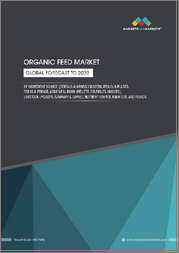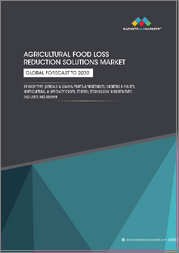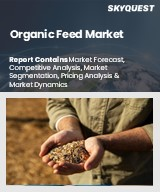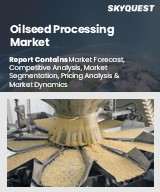
|
시장보고서
상품코드
1457057
세계의 지방종자 시장 예측(2024-2029년)Oilseed Market - Forecasts from 2024 to 2029 |
||||||
오일 씨앗 시장은 복합 연간 성장률(CAGR) 6.72%로 성장할 전망이며 2022년 3,055억 2,600만 달러에서 2029년에는 4,816억 8,300만 달러에 이를 것으로 예측됩니다.
오일 씨앗과 오일 씨앗 가루는 우유의 합성과 발달을 촉진하는 영양소를 제공할 수 있습니다. 가열 처리된 오일 씨앗이나 오일 씨앗 가루를 사용하는 경우, 루미널 효소의 열화나 섭취를 방해하는 유기 효소의 저해에 대해 아미노를 최적으로 보존하기 위해서 적절한 가열 처리를 실시하는 것 필수적입니다. 오일 씨앗 작물의 제품별(외피, 밀, 오일 등)은 영양가가 높기 때문에 인간과 동물 모두의 식사에 포함되어 있습니다. 대부분의 오일 종자 밀은 단백질로 구성되어 있으며 필수 아미노산을 많이 함유하고 있습니다. 오일 씨앗은 바이오 디젤, 비료, 의약품, 화장품, 사료, 섬유, 페인트, 버튼 등의 산업 제품에 사용됩니다. 다양한 용도에서의 유용성과 건강한 라이프스타일의 채용과 함께 가축영양에 대한 수요가 높아지면서 세계 규모 시장 성장을 가속하고 있습니다.
시장 성장 촉진요인
- 다양한 용도로의 이용 확대가 시장 성장을 자극하고 있습니다.
지방산, 기름, 미네랄, 단백질, 비타민, 섬유는 모두 지방종자에 풍부하게 포함되어 있으며 기름 추출에 자주 사용됩니다. 대두유를 추출한 후에 남아있는 영양이 풍부한 펄프는 밀과 오일 케이크로 가공되어 낙농업 종사자 축제의 사료로 급여됩니다. 오일 씨앗은 많은 용도로 매우 인기가 있습니다. 화장품에서는 해바라기와 같은 오일 시드가 보습제로 사용됩니다. 사람들이 동물성 지방보다 식물성 기름을 선택하게 된 이유는 건강을 더욱 선호하기 때문입니다. 또한 오일 씨앗을 보다 효과적으로 생산하기 위한 정부의 이니셔티브도 시장을 견인하고 있습니다. 인도 정부의 보고에 의하면, 농업,농민 복지성(Ministry of Agriculture and Farmers Welfare)의 지방종자과 야자 야자에 관한 국가 미션(National Mission on 지방종자 and Oil Palm : NMOOP)은 계속해서 국내의 지방종자 정책을 감독하고 있습니다. 2022년까지 국가 임무는 3,120만 헥타르에서 생산되는 9종의 오일 씨앗 작물이 4,564만 톤의 국내 오일 씨앗을 생산할 것으로 예상하고 있습니다.
- 지속 가능한 항공 연료에의 응용은 시장 성장을 뒷받침하고 있습니다.
오일 씨앗에는 지속 가능한 항공 연료 생산의 필수적인 부분을 형성하는 작물이 포함되어 전체 탄소 배출을 줄일 수 있습니다. 세계 이산화탄소 배출량을 줄이기 위한 노력 속에서 기존의 등유를 제한하는 것이 중요해지면서 지속 가능한 항공 연료 생산의 필요성이 가속화되고 있습니다. 다양한 투자와 연구 활동이 진행되고 있습니다. 예를 들어, 미국 에너지부는 2022년 12월 미시간 주립 대학의 연구자들에게 200만 달러의 대출을 실시했습니다. 이 연구자들은 양배추와 콜리플라워에 가까운 식물인 카멜리나 사티바에서 더 깨끗하고 지속 가능한 바이오 디젤과 제트 연료를 개발하려고합니다. 이 데이터는 과학자가 이 식물의 생산을 이해하고 항공 요건을 충족하는 현재의 석유계 연료를 대체하는 보다 경쟁적인 연료로 만드는 데 도움이 될 것으로 예상됩니다.
작물 유형별로는 콩과 해바라기 씨앗이 압도적인 점유율을 차지하고 있습니다.
작물별로 해바라기는 바이오연료 제조에 널리 사용되기 때문에 지방종자 시장의 상당 부분을 차지합니다. 또한 해바라기유는 오메가 6 지방산을 함유하기 때문에 영양가가 높고 건강에도 좋은 점에서 소비자에게 널리 소비되고 있습니다. 해바라기 씨앗은 분말 형태로도 일반적으로 사용되며 해바라기 오일 씨앗 시장에 대한 수요를 높이고 있습니다. 또한, 사람들의 건강 지향이 높아짐에 따라 대두유 소비량도 증가하고 있습니다. 콩은 영양면에서 우수하기 때문에 식품 사업에서 콩 수요는 시대와 함께 높아지고 있습니다. 이것은 대두유 생산량 증가로 이어지고, 대두의 오일 씨앗 시장 확대에 박차를 가하고 있습니다.
아시아태평양은 지역별 시장에서 가장 높은 성장률이 예상됩니다.
개인의 가처분소득 증가, 식품가공산업 확대, 동지역의 소매부문에 따라 아시아태평양은 예측기간 동안 기름종자시장에서 가장 빠른 성장을 이룰 것으로 예측되고 있습니다. 게다가 신흥국 시장의 개척이 진행되고 있는 중국도 아시아태평양지방종자 시장에서 건전한 성장을 이룰 것으로 예측되고 있습니다. 예를 들면, 2022년 12월에 랴오닝성 대련의 대련상품거래소(DCE)에서 1호 대두, 2호 대두, 대두밀, 대두유를 포함한 8개의 대두 관련 선물,옵션이 외국인 트레이더에 정식으로 개방 되었습니다. 중국은 세계적으로 비유전자 대두의 중요한 생산국이자 유전자 변형 대두의 중요한 시장이기도 합니다.
북미는 생산량의 확대와 미국인의 일상생활에서 식용유의 사용량 증가에 의해 세계 기름씨 시장에서 큰 비율을 차지하고 있습니다. 또한 미국산 대두 생산량이 증가했기 때문에 대두유 소비량이 증가하여 시장 확대가 더욱 가속화되었습니다. 세계무역기구(WTO)의 보고에 따르면 미국은 세계 2위의 대두 수출국이며 세계 유수의 대두 생산국입니다.
목차
제1장 서론
- 시장 개요
- 시장의 정의
- 조사 범위
- 시장 세분화
- 통화
- 전제조건
- 기준년과 예측년의 타임라인
- 관계자에게 있어서의 주요 이점
제2장 조사 방법
- 조사 디자인
- 조사 과정
제3장 주요 요약
- 주요 조사 결과
- 애널리스트 보기
제4장 시장 역학
- 시장 성장 촉진요인
- 시장 성장 억제요인
- Porter's Five Forces 분석
- 업계 밸류체인 분석
- 애널리스트 보기
제5장 지방종자 시장 : 작물 유형별
- 소개
- 카놀라
- 유채 및 겨자
- 콩
- 해바라기
- 기타
제6장 지방종자 시장 : 유형별
- 소개
- 유전자 변형 작물
- 기존
제7장 지방종자 시장 :지역별
- 소개
- 북미
- 남미
- 유럽
- 중동 및 아프리카
- 아시아태평양
제8장 경쟁 환경과 분석
- 주요 기업과 전략 분석
- 시장 점유율 분석
- 합병, 인수, 합의 및 콜라보레이션
- 경쟁 대시보드
제9장 기업 프로파일
- BASF SE
- Bayer AG
- Bunge Limited
- KWS SAAT SE & Co. KGaA
- Syngenta
- Corteva
- Cargill
The oilseed market is projected to grow at a CAGR of 6.72% to reach US$481.683 billion in 2029 from US$305.526 billion in 2022.
Oilseeds and oilseed meals can provide nutrients that promote milk synthesis and development. When using heat-treated oilseeds or oilseed meals, it is essential to apply the proper heat treatment to provide the optimum preservation of amino against ruminal enzyme deterioration and inhibition of organically present enzymes that impede ingestion. Due to their nutritional profiles, oilseed crops' byproducts (such as hull, meal, and oil) have been incorporated into the diets of both humans and animals. Most oilseed meals are made up of proteins and have high levels of essential amino acids. Several industrial products utilize oilseeds, including biodiesel, fertilizer, medications, cosmetics, animal feeds, fibers, paint, buttons, etc. Growing demand for livestock nutrition coupled with utility in various applications and adoption of healthy lifestyle has propelled the market growth at global scale.
Market Drivers
- The expanding utilization across various applications is stimulating the market growth.
Fatty acids, oil, minerals, protein, vitamins, and fiber are all abundant in oilseeds and are frequently employed in extracting oil. The nutrient-rich pulp left behind after soybean oil extraction is turned into meals or oilcakes and fed to dairy farm animals to increase milk production and quality while reducing feed requirements. Oilseeds are highly sought-after due to their numerous uses. In cosmetic goods, oil seeds like sunflower are utilized as a moisturizer. People are choosing vegetable oil over animal fat because they prioritize their health more. The market is also being driven by government initiatives to produce oilseeds more effectively. According to Indian government reports, the Ministry of Agriculture and Farmers Welfare's National Mission on Oilseeds and Oil Palm (NMOOP) continues to oversee domestic oilseed policy. By 2022, the National Mission expects nine oilseed crops produced on 31.2 million hectares to produce 45.64 MMT of domestic oilseeds.
- Growing applicability in sustainable aviation fuel has bolstered the market growth.
Oilseed includes crops that form an integral part of sustainable aviation fuel production, thereby reducing the overall carbon emission. The growing emphasis to limit conventional kerosene in efforts to reduce the global carbon footprint has accelerated the need for sustainable aviation production which is expected to pave the way for future market growth for oilseed. Various investments and research activities are being undertaken. For instance, The U.S. Department of Energy awarded US$2 million in financing to researchers at Michigan State University in December 2022. These researchers are trying to develop cleaner, more sustainable biodiesel and jet fuels from Camelina sativa, a plant related to cabbage and cauliflower. This data will assist scientists in understanding the plant's oilseed production and make it a more competitive substitute for the current petroleum-based fuels that meet aviation requirements.
Soybean and sunflower seeds accounted for a dominant share by crop type.
In terms of crop, the sunflower category accounts for a sizable portion of the oilseeds market due to its extensive use in biofuel creation. Sunflower oil is also widely consumed by consumers due to its high nutritional value and health advantages, as it includes omega-6 fatty acids. Sunflower seeds are also commonly used in powder form, which increases demand for the sunflower oilseed market. Furthermore, the consumption of soybean oil has increased as a result of the rise in the health-conscious nature of people. Because of the nutritional benefits of soybeans, the demand for them in the food business has grown over time. This has led to an increase in the production of soybean oil, which has fueled the expansion of the oilseed market for soybean.
The Asia Pacific region is expected to witness the highest growth rate among regional markets.
Due to rising personal disposable income, expanding food processing industries, and the region's retail sector, Asia-Pacific is anticipated to experience the fastest growth in the oilseeds market over the projection period. Moreover, due to the growing number of technical developments, China is also predicted to expand at a healthy rate in the Asia-Pacific oilseeds market. The country is witnessing new collaboration to bolster its foreign trade, for instance, in December 2022, at the Dalian Commodity Exchange (DCE) in Dalian, Liaoning province, eight soybean-related futures and options, including No. 1 soybean, No. 2 soybean, soybean meal, and soybean oil, were formally opened to foreign traders. China is a significant producer of non-GMO soybeans globally and a substantial market for GMO soybeans.
North America holds a sizeable percentage of the world's oil seed market due to the expansion of oilseed production and the rise in the usage of edible oils in the daily lives of Americans. Additionally, the U.S. soybean crop was produced in greater quantities, which led to rising soybean oil consumption and further accelerated market expansion. The World Trade Organization reports that the United States is the second-largest exporter and one of the leading producers of soybeans worldwide.
Key Developments
- In March 2023: Chevron USA, Bunge, and Corteva Inc. formed a strategic collaboration for the development of winter canola hybrids and used the same for making low-carbon profile plant-based oil. The new production aims to meet the demand for growing low-carbon renewable fuels.
- In August 2022: Bayer formed a shareholder's agreement along with Chevron USA and Bunge where the former would acquire a 65% stake in winter oilseed producer CoverCress Inc. whereas Bunge and Chevron will have joint ownership of the remaining 35%.
Segmentation:
By Crop Type
- Canola
- Rapeseed & Mustard
- Soybean
- Sunflower
- Others
By Type
- GMO
- Conventional
By Geography
- North America
- USA
- Canada
- Mexico
- South America
- Brazil
- Argentina
- Others
- Europe
- Germany
- France
- United Kingdom
- Spain
- Others
- Middle East And Africa
- Saudi Arabia
- Israel
- Other
- Asia Pacific
- China
- Japan
- India
- South Korea
- Indonesia
- Taiwan
- Others
TABLE OF CONTENTS
1. INTRODUCTION
- 1.1. Market Overview
- 1.2. Market Definition
- 1.3. Scope of the Study
- 1.4. Market Segmentation
- 1.5. Currency
- 1.6. Assumptions
- 1.7. Base, and Forecast Years Timeline
- 1.8. Key Benefits to the Stakeholder
2. RESEARCH METHODOLOGY
- 2.1. Research Design
- 2.2. Research Processes
3. EXECUTIVE SUMMARY
- 3.1. Key Findings
- 3.2. Analyst View
4. MARKET DYNAMICS
- 4.1. Market Drivers
- 4.2. Market Restraints
- 4.3. Porter's Five Forces Analysis
- 4.3.1. Bargaining Power of Suppliers
- 4.3.2. Bargaining Power of Buyers
- 4.3.3. Threat of New Entrants
- 4.3.4. Threat of Substitutes
- 4.3.5. Competitive Rivalry in the Industry
- 4.4. Industry Value Chain Analysis
- 4.5. Analyst View
5. OILSEED MARKET BY CROP TYPE
- 5.1. Introduction
- 5.2. Canola
- 5.2.1. Market Trends and Opportunities
- 5.2.2. Growth Prospects
- 5.2.3. Geographic Lucrativeness Insight
- 5.3. Rapeseed & Mustard
- 5.3.1. Market Trends and Opportunities
- 5.3.2. Growth Prospects
- 5.3.3. Geographic Lucrativeness Insight
- 5.4. Soybean
- 5.4.1. Market Trends and Opportunities
- 5.4.2. Growth Prospects
- 5.4.3. Geographic Lucrativeness Insight
- 5.5. Sunflower
- 5.5.1. Market Trends and Opportunities
- 5.5.2. Growth Prospects
- 5.5.3. Geographic Lucrativeness Insight
- 5.6. Others
- 5.6.1. Market Trends and Opportunities
- 5.6.2. Growth Prospects
- 5.6.3. Geographic Lucrativeness Insight
6. OILSEED MARKET BY TYPE
- 6.1. Introduction
- 6.2. GMO
- 6.2.1. Market Trends and Opportunities
- 6.2.2. Growth Prospects
- 6.2.3. Geographic Lucrativeness Insight
- 6.3. Conventional
- 6.3.1. Market Trends and Opportunities
- 6.3.2. Growth Prospects
- 6.3.3. Geographic Lucrativeness Insight
7. OILSEED MARKET BY GEOGRAPHY
- 7.1. Introduction
- 7.2. North America
- 7.2.1. By Crop Type
- 7.2.2. By Type
- 7.2.3. By Country
- 7.2.3.1. USA
- 7.2.3.1.1. Market Trends and Opportunities
- 7.2.3.1.2. Growth Prospects
- 7.2.3.2. Canada
- 7.2.3.2.1. Market Trends and Opportunities
- 7.2.3.2.2. Growth Prospects
- 7.2.3.3. Mexico
- 7.2.3.3.1. Market Trends and Opportunities
- 7.2.3.3.2. Growth Prospects
- 7.2.3.1. USA
- 7.3. South America
- 7.3.1. By Crop Type
- 7.3.2. By Type
- 7.3.3. By Country
- 7.3.3.1. Brazil
- 7.3.3.1.1. Market Trends and Opportunities
- 7.3.3.1.2. Growth Prospects
- 7.3.3.2. Argentina
- 7.3.3.2.1. Market Trends and Opportunities
- 7.3.3.2.2. Growth Prospects
- 7.3.3.3. Others
- 7.3.3.3.1. Market Trends and Opportunities
- 7.3.3.3.2. Growth Prospects
- 7.3.3.1. Brazil
- 7.4. Europe
- 7.4.1. By Crop Type
- 7.4.2. By Type
- 7.4.3. By Country
- 7.4.3.1. Germany
- 7.4.3.1.1. Market Trends and Opportunities
- 7.4.3.1.2. Growth Prospects
- 7.4.3.2. France
- 7.4.3.2.1. Market Trends and Opportunities
- 7.4.3.2.2. Growth Prospects
- 7.4.3.3. United Kingdom
- 7.4.3.3.1. Market Trends and Opportunities
- 7.4.3.3.2. Growth Prospects
- 7.4.3.4. Spain
- 7.4.3.4.1. Market Trends and Opportunities
- 7.4.3.4.2. Growth Prospects
- 7.4.3.5. Others
- 7.4.3.5.1. Market Trends and Opportunities
- 7.4.3.5.2. Growth Prospects
- 7.4.3.1. Germany
- 7.5. Middle East and Africa
- 7.5.1. By Crop Type
- 7.5.2. By Type
- 7.5.3. By Country
- 7.5.3.1. Saudi Arabia
- 7.5.3.1.1. Market Trends and Opportunities
- 7.5.3.1.2. Growth Prospects
- 7.5.3.2. Israel
- 7.5.3.2.1. Market Trends and Opportunities
- 7.5.3.2.2. Growth Prospects
- 7.5.3.3. Others
- 7.5.3.3.1. Market Trends and Opportunities
- 7.5.3.3.2. Growth Prospects
- 7.5.3.1. Saudi Arabia
- 7.6. Asia Pacific
- 7.6.1. By Crop Type
- 7.6.2. By Type
- 7.6.3. By Country
- 7.6.3.1. China
- 7.6.3.1.1. Market Trends and Opportunities
- 7.6.3.1.2. Growth Prospects
- 7.6.3.2. Japan
- 7.6.3.2.1. Market Trends and Opportunities
- 7.6.3.2.2. Growth Prospects
- 7.6.3.3. India
- 7.6.3.3.1. Market Trends and Opportunities
- 7.6.3.3.2. Growth Prospects
- 7.6.3.4. South Korea
- 7.6.3.4.1. Market Trends and Opportunities
- 7.6.3.4.2. Growth Prospects
- 7.6.3.5. Indonesia
- 7.6.3.5.1. Market Trends and Opportunities
- 7.6.3.5.2. Growth Prospects
- 7.6.3.6. Taiwan
- 7.6.3.6.1. Market Trends and Opportunities
- 7.6.3.6.2. Growth Prospects
- 7.6.3.7. Others
- 7.6.3.7.1. Market Trends and Opportunities
- 7.6.3.7.2. Growth Prospects
- 7.6.3.1. China
8. COMPETITIVE ENVIRONMENT AND ANALYSIS
- 8.1. Major Players and Strategy Analysis
- 8.2. Market Share Analysis
- 8.3. Mergers, Acquisitions, Agreements, and Collaborations
- 8.4. Competitive Dashboard
9. COMPANY PROFILES
- 9.1. BASF SE
- 9.2. Bayer AG
- 9.3. Bunge Limited
- 9.4. KWS SAAT SE & Co. KGaA
- 9.5. Syngenta
- 9.6. Corteva
- 9.7. Cargill



















